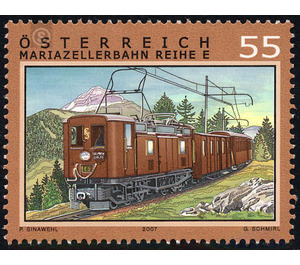100 years - Austria / II. Republic of Austria 2007 - 55 Euro Cent
Theme: Traffic, Transportation & Mobility
| Country | Austria / II. Republic of Austria |
| Issue Date | 2007 |
| Face Value | 55.00 |
| Edition Issued | 600,000 |
| Printing Type | combination printing |
| Stamp Type | Commemorative |
| Item Type | Stamp |
| Chronological Issue Number | 1999 |
| Chronological Chapter | OOS-OE2 |
| SID | 624896 |
| In 57 Wishlists | |
The Mariazellerbahn - one of the most beautiful railway lines in Austria - is a remarkable narrow-gauge railway with a 760mm gauge. It was later electrified as the first Austrian railway line. It gains its status as a means of public transport as well as a tourist attraction. The first plans for this railway line were made shortly after the completion of the western railway line in 1853, but it was not until 1895 that the construction of the "Pielachtalbahn" railway was decided. After two years of construction, the first section from St. Pölten to Kirchberg an der Pielach was opened in 1898. From 1902 followed the further expansion to Gusswerk. On 2 May 2007, the Niederösterreichisch-Stirische Alpenbahn, as the official name read, took the passenger traffic to Mariazell. The first operation on the Mariazell Railway was carried out with Mh. Series steam locomotives specially developed for this route, which quickly proved to be inadequate. The revolutionary proposal of electrification was able to prevail and was realized in the years 1907 to 1911. The Linz-based company Krauss & Comp. built in the years 1911 to 1914 suitable electric motives. They are the oldest electric locomotives in the world, which are still in use today on the track. For electrical operation, a single-phase AC voltage of 6.5kV at 25Hz frequency is still used. The electricity comes from the hydropower plants Wienerbruck and Erlaufboden. The Mariazellerbahn starts in St. Pölten and leads over 85 km across the Alpine foothills. The valley section leaves shortly after St. Pölten the Traisental, changes over gentle heights in the Pielachtal. At Laubenbachmühle begins the mountain route, which overcomes in long loops to Puchenstuben up 356 vertical meters and through 21 tunnels and over 19 viaducts leads. After the 2368 meter long Gösingtunnel, the apex of the route at 892 m above sea level, open magnificent views of the Ötscher and in the upper Erlauftal. A particular attraction is the route "at the tines" with views of the 100 meter deep canyon of Erlauf. Via Mitterbach and past the Gemeindealpe Mariazell is reached. The Mariazellerbahn received by the development of the road a strong competition. The timber transport from the wooded Mariazellergebiet as well as the passenger traffic went back more and more. The closure wave for Nebenbahnen 1988 also hit the Mariazellerbahn. Train after train was set the freight traffic, the route Mariazell - Gusswerk left open. The attractiveness of the railway for tourism in Ötscherland has been able to ward off the threat of a complete attitude for the time being.


